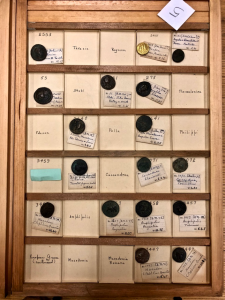
Where are you visiting us from?
I’m in my second year of the Master’s Program in Classical Studies at Columbia.
What is your research project?
My thesis project is the cataloguing of the Roman provincial coins of the Olcott Roman Coin Collection in the Rare Book and Manuscript Library at Butler Library. The objective is to create a catalogue for publication of the provincial coin subset in the Olcott Collection.

How did you become interested in your topic?
My work with the collection began in the spring of 2018 as part of the research for a Columbia course on Roman Coins taught by Lucia Carbone, lecturer in art history and archaeology. It was my first exposure to numismatics and Roman era numismatics. When I saw the chance to work directly with an actual collection and be able to produce a concrete outcome, I was immediately sold. It continues to be fascinating work with equally fascinating discoveries along the way about both the coins and George Olcott himself.
What are you finding in the archive that is relevant to your project?
The collection is my sole focus predicated on the card catalogue written and developed by Olcott coupled with the coins themselves in the collection. What is exciting to me as an archaeologist is the unique opportunity to work with two types of artifacts: written and material (the card catalogue and the coins) from both contemporary and ancient sources.
Even more compelling is that the study arcs between time periods and contexts: Roman period coin circulation, Roman period coin circulation with a lens toward the provinces, numismatic scholarship at the turn of the 20th century when Olcott was creating and documenting his collection, numismatic scholarship that exists today regarding Roman provincial coin issues.
Do you have any advice to other researchers using our collections?
What has worked well for me has been to ask plenty of questions of the librarians and staff who are well-springs of knowledge. They can and do offer short cuts and insights. I’ve also become a quasi-resident of the Butler Library stacks and frequent user of Interlibrary Loan and Borrow Direct, both of which Butler facilitates with ease for Columbia students, faculty and affiliates.
Anything else that you’d like to tell our readers?
Patience is a virtue, accompanied by dogged persistence.

